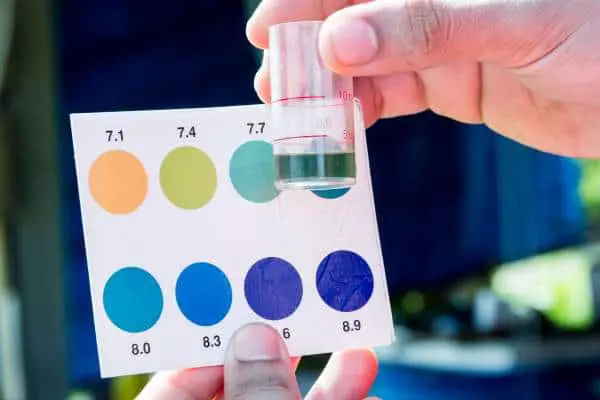Hydroponic growers are faced with many challenges when it comes to monitoring their nutrient solutions and pH levels. We know this can affect how plants grow because some plants require very different ratios to grow to their full potential.
If these two factors were challenging enough, there is one more element in nutrient solutions that needs constant monitoring and adjusting when required. This is the EC level, and here we will see how it affects your plants, how you can test it and how you can adjust it if needed.
Understanding EC Levels
What is the EC in a Nutrient Mix?
EC is the measure of electrical conductivity in any solution. You might also see it as CF which stands for the ‘Conductivity Factor.’
On many occasions, you will see this EC written in conjunction with nutrient solutions pH levels. At this point, you need to know the difference between the two.
The pH levels of your nutrient mix give an indication of nutrient balance in your mix. EC, on the other hand, is an excellent guide to the quantity of available nutrients in your solution.
To make this easy to understand, distilled water contains no EC because it has no minerals contained in it. Once there is an introduction of minerals, salts are dissolved, and then the solution can conduct electricity. The higher the amount of salts, the higher the EC level or the electrical conductivity.
One thing worth noting with EC levels is, it doesn’t tell you what nutrients, and at what levels they are at, it is an overall number of nutrient concentration.
EC Levels in Hydroponics and Why They are Important
Just like pH levels in your hydroponic system, and some plants prefer different levels. It is the same with EC levels, and various plants prefer different levels. On top of this, most plants like the EC level to be in the range of 1.2 – 1.6 in their vegetative stage, and once they reach flowering, they like the EC to be in the range of 1.6 to 2.4.
These levels are worth knowing because, from the following three plants, you can see a vast difference between what levels they prefer.
- Basil & other herbs – EC 0.8 – 1.4
- Tomatoes – EC 2.2 – 2.8
- Spinach – EC up to 3.5
Now we know what can affect EC levels, we need to understand why they are essential. These levels provide a detailed indication of what is happening in your nutrient solution, especially when tests are carried out as an addition to testing pH levels alone.
Here is a brief overview of what is happening with plants when the EC levels change:
- EC level remains the same – the plants are absorbing the same amount of water as nutrients. When this happens, and reservoir levels drop, you need to top up with a nutrient mix of the same strength. This does still require checking once it has stabilized and run through your system.
- EC levels drop – when this happens, it shows the plants are using more nutrients (salts) than they are using water. When this happens, you need to top back up your reservoir to the level it was, and it might mean you need to make the concentration of your newly added nutrients a little stronger. This does need to be checked after topping up in case your solution ends up too strong.
- EC levels rise – this happens when your plants are using more water than they are using nutrients. You may have seen this and know the symptoms as ‘Nutrient burn.’ To resolve this, you need to dilute the solution with more water. Again, your solution will require checking in case it falls off and goes in the opposite direction.
EC Levels and Plant Growth
There are a few things growers should know about EC levels, and this is what happens to a plants growth, and what factors can make EC levels change. There are elements which can affect these levels aside from the amount of nutrients plants are absorbing.
We have seen why these levels are significant, and here is how it affects plants during different stages of their growth.
How Conductivity Levels Will Affect Plant Growth
Seedlings, cuttings or delicate plants will suffer from nutrient burn when the EC level is too high. This ‘too high’ doesn’t mean you have it wrong because even a nutrient mix that is suitable for larger plants can be too strong. To make sure your plants don’t suffer from nutrient burn during these stages, it is advisable to run your nutrient levels at half strength or lower.
Once plants become more substantial and are entering their vegetative stage, you can increase the nutrient concentration. This is still dependent on the type of plant you are growing. If you have a mixture of plants, you need to separate these into light feeders, medium feeders, and heavy feeders if possible. If you have three different types of plants which all feed at different rates, this means you will need three separate reservoirs.
This might seem too much, and it might not fit in with everyone’s hydroponic system, but as a good example. If you feed lettuce with high EC levels that are suited to tomatoes, then your lettuce will become bitter. At the other end of the scale, if you feed tomatoes with low EC levels intended for lettuce, then your tomatoes won’t have any taste.
Can Water Temperature Affect EC Levels?
Nutrient solutions in your reservoir should fall inside the temperature range of 65 – 80 degrees Fahrenheit. Plants don’t like a rapid change in water temperature. This is more important around the root zone. When you are about to add water to your reservoir, you should make sure it is at the same temperature as what is already in the reservoir.
If your grow room is indoors and you fill from an outside hose, this could cause too much of a difference.
Ambient temperatures will also have an effect, so depending on where your system is situated, you might need to make use of an aquarium heater for colder regions, or a suitable chiller for your nutrient solution if you live in warmer climates.
How Does Air Affect EC Levels?
All growers know that plants require airflow to grow correctly, but many are not aware that ventilation plays a significant part in EC levels.
One thing to note is that airflow isn’t the same as ventilation. Airflow is the moving of the same air while ventilation is discarding of old air while introducing fresh air. When you have improved ventilation in your growing area, this aids much higher rates of transpiration. From this, plants will increase their rate of nutrient absorption and uptake.
EC Management
When you have a good EC management procedure in place, you are in a position to help your plants deal with changing conditions. Many growers use low-light conditions and raise their EC levels. This restricts vegetative growth and helps counteract stretching.
When plants are in low humidity areas with high heat, growers can reduce their EC levels to ease any stress on their plants.
Testing EC Levels in Hydroponics
Testing EC levels is no harder than testing pH levels in your solution, but there are a few terms and things you should know.
Terminology Related to EC Levels
- EC – Electrical Conductivity. A measure of the total dissolved salts/ solids in your nutrient solution.
- CF – Conductivity Factor. Another term for the above EC.
- TDS – Total Dissolved Solids. This is read in ppm (Parts Per Million)
- PPM – Parts Per Million. This is a standard measuring unit of elements which are in your nutrient solution. When you have one ppm, this equates to one part of the (solid) weight of any given mineral in one million parts of the solution.
- MilliSiemens – this is a measure of electrical conductance
Converting Between TDS and EC Values
Again, this might sound complicated, and when you come to take readings, your testing meter will do this conversion for you for whichever value you are using.
When you want to find the approximate values of sodium chloride (salt) TDS in your solution, all you need to do is to multiply your EC reading (in milliSiemens/cm) by 1000, and then divide the result by 2.
If you want to convert the other way to find out an EC level from a TDS reading, it is a matter of doing things in reverse. All you need to do here is multiply your ppm reading by two, and then divide the result by 1000.
It is far better to rely on a meter when it comes to taking readings than converting manually.
The EC vs. TDS Debate
There has been a debate in the hydroponics world, and this is because you can test nutrient solutions with different TDS meters and come up with mixed results. This purely boils down to there being different conversion factors, and some manufacturers use different calculations to come up their results. No matter which meter you use for TDS readings, you should only take the results as what they are, an approximation.
These TDS meters use an internal conversion formula to display the EC level as an average ppm. In most cases, this comes out at a 700:1 ratio. This will mean that when you have an EC of 1, you then have 700 ppm. Other makers of these meters use 500:1 ratios for their calculations, and with this difference, it is easy to see why there is such a debate.
The safest route for growers is in using the 700:1 ratio and the reason for this being it is safer and better for your plants to add too little nutrients. If they begin showing signs of nutrient deficiency, then it is much easier to add more than to dial back the strength to a weaker solution.
To reiterate about nutrient strength during different stages of plant growth, you are far better to keep things simple and using nutrient solutions at half-strength during any vegetative phase, and then increasing them to full strength during flowering and fruiting stages.
To keep things on a level, it should also be standard practice to empty and refill your reservoir on a regular basis
The good news is, when you read EC levels, this will return the same results no matter who manufactures the meter.
EC Meters
Testing meters come with many names. They can be EC meters, CF meters, and Truncheon meters. These are all basically the same device, but in looks, they might appear very different.
Digital EC meters can take readings and do all the calculations for you internally. A Truncheon meter, on the other hand, does a reading, and on the side, there are 3 scales, so when the mark stops, you then have your three levels.
For new growers, these digital meters are the better option. They can be faster in operation, and although the Truncheon meter is manually read, it is a lot more expensive than digital.
When taking EC readings, this needs to be performed on a daily basis because things can change rapidly, and as we saw earlier, weather and ambient temperatures can play a large part in these changes.
Here are some simple use and maintenance steps for using a digital EC meter.
Maintenance of an EC Meter
- Always be sure to stick to the manufacturer’s instructions and recommendations
- Once you have used the device, always clean the electrode with distilled water and carefully dry with a lint-free cloth.
- On a regular basis, you should clean the electrode with rubbing alcohol. To do this dip and swirl around before giving it a good rinse with distilled water, and drying is as above.
- If there is any reason you need to store it for extended periods, always remove the batteries.
Using an EC Meter to Take Readings
- Remove the end cap which protects the electrode.
- Dip the probe into your reservoir and hold in place for up to 2 minutes or as advised by the maker of the meter. During this time, the meter will be reaching the same temperature as your nutrient solution.
- Once done, you can pull out the device and take the reading from the digital display. Many meters come with various buttons you can press to reach the other readings.
Organic Fertilizers and EC Levels
While reading EC levels can be very beneficial for your hydroponics system, when growers use organic fertilizers things can become very misleading. This is because the molecules in organic fertilizers usually don’t conduct any electricity.
Growers are still recommended to take EC readings with the aim of determining the soluble salt levels.
It is the case though that many of the nutrients won’t register on EC readings due to the form they are in. In most cases, they won’t have been broken down into simple salts. When readings are taken with EC meters, the gained results will more than likely read much lower than if they were using non-organic nutrients.
What growers tend to find is that although readings are lower, plants are showing no signs of deficiency. This means that nutrient profiles must be adjusted for use with these organic fertilizers.
Calcium can be one mineral which is lacking and can sit at around 100 ppm which is a long way from the recommended 200 ppm for leafy green vegetables. But, with the level at only half of the suggested, these leafy greens don’t show signs of calcium deficiency. One compound that can be added to rectify this is calcium sulfate.
It has been found both calcium and magnesium lacking when using organic fertilizers, but, if growers are using regular water, these deficiencies can be made up. However, this doesn’t help if you are using pure water.
Regular water contains 30 ppm of both calcium and magnesium, and over extended periods (several months) calcium levels naturally increase inside your reservoir, and can almost reach the recommended 200 ppm. Magnesium can naturally increase over time in the same way.
One thing which has been found when using organic fertilizers is that the smaller the reservoir, the more frequent testing must be carried out.
Conclusion
As you can see, on paper EC levels, look hard to control, but in reality, they are as easy to test for and to adjust as pH levels are.
Learning how to fine tune your hydroponic EC levels brings many more benefits than choosing to ignore it, and this can be evident when you have symptoms such as nutrient burn, or you are beginning to have vegetables with little taste.
All the formula are best remembered, but with a digital meter to take the readings, adjusting your EC levels works out to nothing more than dilution. As long as you can keep the EC levels on the right side, it is straightforward to adjust so your plants can grow to their full potential.





